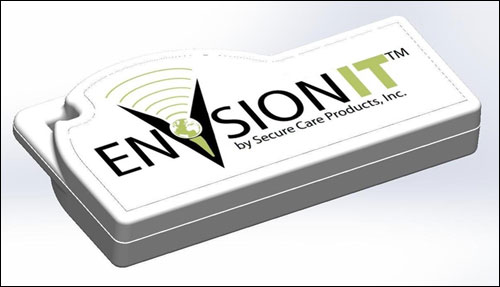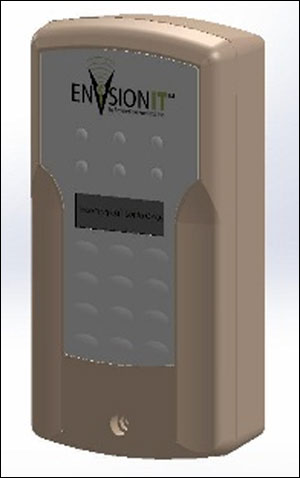Secure Care Products Inc., a provider of RF-based electronic products to the health-care sector, reports that two of its customers will trial the company’s new real-time location system (RTLS), known as EnVisionit, that offers such features as location granularity of 1 foot or less, as well as tags and a single platform to manage all RTLS solutions tracking everything from patients to assets and temperatures. Trials are slated to begin this year, says Al Larose, Secure Care’s director of engineering, and a full product launch will take place during the third quarter of 2014.
The solution—Secure Care’s first RTLS offering—provides improved location accuracy with fewer readers than most RTLS solutions, the company claims. In addition, the firm notes, by establishing a replacement program for the active ultra-wideband (UWB) tags, Secure Care offers customers better assurance against dead batteries, which render tags unusable. In the case of most RTLS solutions, users must periodically locate tags with expiring batteries and replace those batteries before they die entirely. Otherwise, those tags can be very difficult to find. To eliminate this problem, Secure Care automatically sends replacement tags to the hospital, according to a schedule it sets up. The hospital then replaces every tag it has have—which, Larose explains, is simpler than regularly looking for specific tags losing battery charge and replacing or recharging only those batteries.

For three decades, Secure Care, based in Concord, N.H., has been selling health-care security solutions that include infant-security and patient-wandering protection systems. It manufactures its own tags and readers in New Hampshire.
The company began investigating RTLS solutions in recent years, in order to offer greater functionality to its health-care customers. Its goal was to provide a single platform that hospitals could use to track patients, personnel and assets in real time. In response, Secure Care’s engineers developed the EnVisionit system, which employs UWB transponders for monitoring infants, patients, employees, equipment and storage temperatures. The engineers also developed devices known as nodes, which act as tag readers. Because the tags utilize UWB technology to transmit their signals, the location data’s granularity is to within a foot or less, says Steve Buhler, Secure Care’s VP of business development and partner alliances. That granularity, he notes, also results from the hardware design, which was three years in the making. The design includes a low-power chip that yields a longer operating life for the tag’s battery.
According to Buhler, EnVisionit can be installed for a specific use case, such as infant tracking, and can be scaled to include other use cases as well, such as monitoring assets, by simply applying additional tags. A hospital can acquire the EnVisionit software and install it on its own back-end system, or lease the software in the form a cloud-based service provided by Secure Care, thereby allowing access to such information as each tag’s location, and analytics related to those locations or the tagged asset’s status—for instance, “in-use,” “available” or “requiring maintenance.”
Secure Care’s strength, Buhler says, is that the company has a legacy of expertise in the health-care sector for monitoring patients and personnel. As such, he adds, the company is able to apply technology solutions to problems that it “already has deep understanding in.”
Each UWB node can be installed with Power over Ethernet (PoE) or a cabled power connection. The node receives signals transmitted by the active, beaconing tags, and can forward that data to the back-end server, either via the cabled connection or Wi-Fi. (The nodes can transmit the tag data to the server via a Wi-Fi wireless signal using either the 2.4 GHz or 5.2 GHz band, thereby reducing the potential for bandwidth traffic problems within the hospital.) The EnVisionit software determines the tag’s location based on the time difference of arrival (TDOA), and can also prompt the closing and locking of a door if, for example, an infant tag is read within close proximity of the exit.

Buhler says the pilots will include multiple applications of the technology. For example, tags would be supplied to patients arriving at the emergency room or at a clinic within the hospital. Each tag’s location will be updated as the corresponding patient moves around the facility. Assets will also be tagged, and will beacon their own unique identifiers, which will then be captured by nodes and forwarded to the software. If a specific piece of equipment comes within close range of a patient, or if an employee wearing a UWB badge comes within close range of a patient, the software will identify that action. The hospital would then be able to use that information to determine which procedures and services were provided to each patient, as well as when this occurred. The software will also collect patient dwell times, and ascertain where there may be bottlenecks in the service being received. Moreover, it will be able to identify, in real time, if a patient has been waiting too long at any particular area, such as in a hallway or waiting room.
Additionally, EnVisionit temperature-sensing tags could be installed inside coolers, enabling the software to send alerts to management in the event that preset temperatures level were exceeded. Tags on products within the coolers can also monitor what is being stored, and when it may be removed from that cooler and subsequently returned.
With each installation, Secure Care will establish a replacement rate for the tags, based on how they are used—for example, how often they are programmed to beacon. The company will then supply replacement tags (every one or four years, for instance), instructing the customer to swap the new tags for those previously deployed and send the used ones back to Secure Care. The company will then refurbish the tags for reuse and recycle their batteries.
Secure Care is manufacturing a variety of UWB tags, including models with adhesive backings for attachment to assets, in addition to wrist or ankle bands for infants. Adult patients and personnel can use another type of tag that can be worn as a badge or lanyard and comes with an alert button, which a person can press to indicate an urgent need for help.



